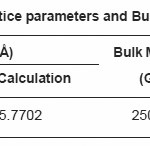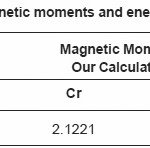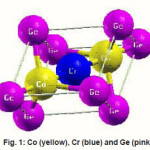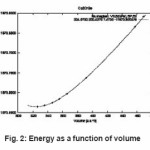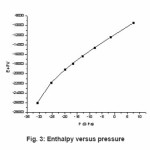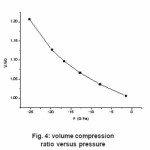D. P. Rai, Amit Shankar, Sandeep, M. P. Ghimire and R. K. Thapa
Department of Physics,Mizoram University, Aizal - 796 004, India.
DOI : http://dx.doi.org/10.13005/msri/090122
Article Publishing History
Article Received on : 03 Jan 2012
Article Accepted on : 19 Feb 2012
Article Published :
Plagiarism Check: No
Article Metrics
ABSTRACT:
The structural and magnetic properties of Co2CrGe, a Heusler alloy have been evaluated by first principles density functional theory through total energy calculations at 0 K by the full potential linearized augmented plane wave (FP-LAPW) method as implemented in WIEN2K code. The calculated results were compared with the previously reported results. Generalized gradient approximation (GGA) was used to study the structural and magnetic properties of Co2CrGe.
KEYWORDS:
Magnetic properties; Heusler alloy; Total energy
Copy the following to cite this article:
Rai D. P, Shankar A, Sandeep, Ghimire M. P, Thapa R. K. A Ground State Study of Structural and Magnetic Properties of Co2CrGe: A GGA Method. Mat.Sci.Res.India;9(1)
|
Copy the following to cite this URL:
Rai D. P, Shankar A, Sandeep, Ghimire M. P, Thapa R. K. A Ground State Study of Structural and Magnetic Properties of Co2CrGe: A GGA Method. Mat.Sci.Res.India;9(1). Available from: http://www.materialsciencejournal.org/?p=1221
|
Introduction
Heusler alloys are the ternary intermetallich compounds with compostion X2YZ, where X and Y are transition elements (Ni, Co, Fe, Mn, Cr, Ti, V etc.) and Z is III, IV or V group elements (Al,Ga, Ge, AS, Sn, In etc.). One of the promising classes of materials is the half-metallic ferrimagnets, i.e., compounds for which only one spin channel presents a gap at the Fermi level, while the other has a metallic character, leading to 100% carrier spin polarization at EF.1 After that, half-metallicity attracted much attention,2 because of its prospective applications in spintronics.3 The electronic and magnetic properties of Co2MnAl4 and Co2CrSi5 using LSDA shows the half-metallicity at the ground state. In this paper, we have studied the various ground state and structural properties of Co2CrGe using full potential linearized augmented plane wave (FP-LAPW) method within GGA.
Crystal Structure
Heusler alloy6 with chemical formula X2YZ (X = Co, Y = Cr and Z = Ge). The full Heusler structure consists of four penetrating fcc sublattices with atoms at X1(1/4,1/4,1/4), X2(3/4,3/4,3/4), Y(1/2,1/ 2,1/2) and Z(0,0,0) positions which results in L21 crystal structure having space group Fm-3-m.
Computation Detail
A computational code (WIEN2K)7 based on FP-LAPW method was applied for structure calculations of Co2CrGe. GGA8 was used for the exchange correlation potential. The multipole exapansion of the crystal potential and the electron density within muffin tin (MT) spheres was cut at l=10. Nonspherical contributions to the charge density and potential within the MT spheres were considered up yo lmax=6 . The cut-off parameter was RKmax=7. In the interstitial region the charge density and the potential were expands as a Fourier series with wave vectors up to Gmax=12 a.u-1. The MT sphere radii(R) used were 2.35 a. u. for Co, 2.35 a.u. for Cr and 2.21 a. u. for Ge. The number of k-points used in the irreducible part of the brillouin zone is 286.
Results and Discussion
The calculated total energies within GGA as function of the volume were used for determination of theoretical lattice constant and bulk modulus. Equilibrium lattice constant, isothermal bulk modulus, its pressure derivative are calculated by fitting the calculated total energy to the Murnaghan’s equation of state.9
The plot of energy versus volume is shown in Fig 2. The volume with respect to the lowest energy as shown in fig. 2 is used for determination of equilibrium lattice constant. The calculated values of lattice constant and bulk modulus are presented in Table 1. The calculated bulk modus is 250.4376 GPa and its pressure derivative is found to be 7.4730. The optimized lattice constants for Co2CrGe is 5.7702 which is presented. The change in the lattice constant of Co2CrGe with that of previous result is 0.53% more. The enthalpy of the system was calculated by using the equation (H),

where P is the bulk pressure, V is bulk volume and E is the Energy of the system. The plot of enthalpy versus Pressure is depicted in Fig. 3. Fig. 3 shows the enthalpy (H) is increasing and finally reaches stable volume 324.0732 a. u-3 at – 9452.0364 Ry. In Fig. 4 it is shown the isothermal equation of states was obtained as a function of the volume compression ration V/Vo , where V and Vo are the compressed and uncompressed volumes, respectively. The volume derivative decreases with the increase in pressure.
Magnetic Properties
respectively. In the case of small magnetic moment compounds, the Co atoms contribute mostly to the moment, as compared with the compounds with large magnetic moments11. It should be noted that Mcal is the total magnetic moment but it is not the sum of the moments of Co, Mn and Z sites only, it also includes the moment of interstitial between the sites. In most cases the moment of Z (Ge) atoms aligned anti-parallel to the X(Co) and Y(Cr) moments as shown in Table 2. In our calculation we obtained the integral value of magnetic moment 3.999 µB when the system is treated with GGA. This proves that the system Co2CrGe treated with GGA can be possible half metal ferromagnet (HMF).
Table 1: Lattice parameters and Bulk modulus
Table 2: Partial magnetic moments and energy gap of Co2CrGe
Figure 1: Co (yellow), Cr (blue) and Ge (pink)
Figure 2: Energy as a function of volume
Figure 3: Enthalpy versus pressure
Figure 4: volume compression ratio versus pressure
Conclusion
The ground state structural optimization was performed to obtain the equilibrium energy. We have studied the possibility of appearance of half-metallicity in the case of the full Heusler compounds Co2CrGe, where Ge is a sp atom belonging to the IVB column of the periodic table. We found that in Co2CrGe the ferromagnetic is stable at the equilibrium lattice constant. The calculated value of magnetic moment is 3.999 µB wihich is in qualitative agreement with the previously reported result.10 The integral value of magnetic moment is one of the evidences to prove the Half Metallic Ferromagnet nature for Co2CrGe.
Acknowledgments
DPR acknowledges DST Inspire research fellowship, AS and RKT a research grant from UGC, (New Delhi, India).
References
- de Boeck, van Roy W., Das J., Motsnyi V., Liu Z., Lagae L., Boeve H., Dessein K. and Borghs G., Semicond. Sci. Technol., 17: 342 (2002).
- Katsnelson M. I., Irkhin V. Y., Chioncel L.,Lichtenstein A. I., and de Groot R. A., Rev.Mod. Phys., 80: 315-378 (2008).
CrossRef
- Zutic I., Fabian J., and Sarma S. D., Rev. Mod.Phys., 76: 323-410 (2004).
CrossRef
- Rai D. P., Hashemifar J., Jamal M.,Lalmuanpuia, Ghimire M. P., Sandeep,Khathing D. T., Patra P. K., Sharma B. I.,Rosangliana and Thapa R. K., Indian J. Phys,84(5): 593-595 (2010).
- Rai D. P., Sandeep, Ghimire M. P. and Thapa R. K., Bull. Mat. Sc, 34: 1219-1222 (2011).
CrossRef
- Heusler O ., Ann.Phys. 19: 155 (1934).
CrossRef
- Blaha P., Schwarz K., Madsen G. K. H., Kvasnicka D., Luitz J., Schwarz K., Wien2K User’s Guide, Vienna University of Technology (2008).
- Perdew J. P., Burke S., Ernzerhof M., Phys.Rev. Lett. 77: 386 (1996).
CrossRef
- Murnaghan F. D. Proc. Natl. Acad. Sci. USA,30: 244 (1944).
CrossRef
- Gilleßen M., Von der Fakult¨at f¨ur Mathematik, Informatik und Naturwissenschaften der RWTH Aachen University zur Erlangung des akademischen Grades eines Doktors der Naturwissenschaften genehmigte Dissertation (2009).
- Kandpal H. C., Fecher G. H., and Felser C., Calculated electronic and magnetic properties of the half-metallic, transition metal based Heusler compounds, arXiv: cond-mat/0611179v1 [cond-matm-matrl-sci] (2006).

This work is licensed under a Creative Commons Attribution 4.0 International License.
 Material Science Research India An International Peer Reviewed Research Journal
Material Science Research India An International Peer Reviewed Research Journal

